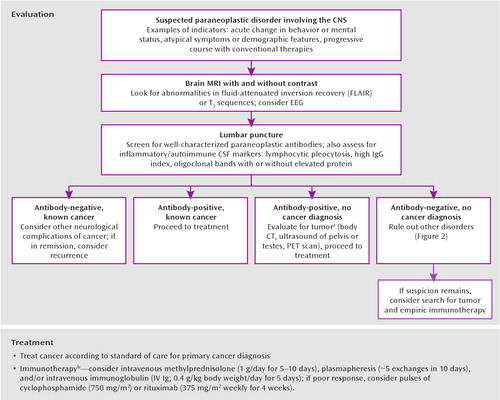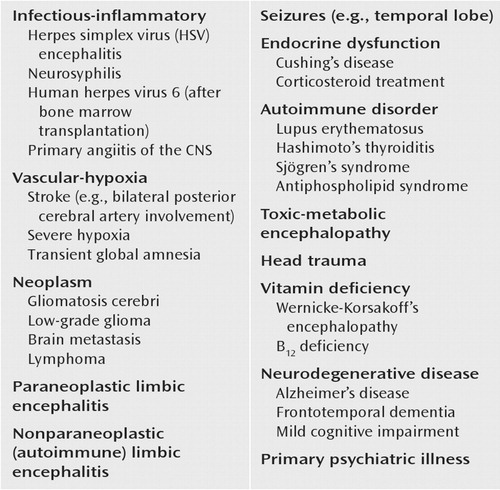Paraneoplastic syndromes most commonly. Paraneoplastic syndromes are signs or symptoms that occur as a result of organ or tissue damage at locations remote from the site of the primary tumor or metastases.

Psychiatric Manifestations Of Paraneoplastic Disorders American Journal Of Psychiatry
Paraneoplastic syndromes associated with lung cancer can impair various organ functions and include neurologic endocrine dermatologi.

. This case involves a 67-year-old female with metastatic. Paraneoplastic neurologic syndromes are a set of rare neurological conditions with a wide variety of presentations ranging from headache to gait imbalance. Hypercalcemia is one of numerous disorders known as paraneoplastic syndromes.
17Paraneoplastic syndromes are manifestations of cancer that often result from. This section outlines the three main paraneoplastic syndromes known to affect cognition their various etiologies and expectations for clinical presentation and test results. A radiation and chemotherapy.
See Page 1 8Paraneoplastic syndromes are manifestations of cancer that often result from. B compression of area vessels. Paraneoplastic syndromes are manifestations in sites that are not directly affected by the disease.
A Radiation and chemotherapyB Compression of area vessels C Tumor-related tissue necrosis D Inappropriate hormone release Ans. Paraneoplastic disorders are not caused by direct tumor invasion metabolic and nutritional deficits infections coagulopathy or side effects of cancer treatment. These conditions are often underreported and underdiagnosed.
Support of immunologic pathogenesis of paraneoplastic disorders many symptoms respond to immunotherapy driving the ongoing search for unknown antibodies when no well-described antibodies are found in available screens. Anti-Hu anti-Ri anti-Yo anti-Ma anti-Ta and anti-Tr or with immunological mechanisms against unknown antigens. The prevalence of paraneoplastic syndromes depends on the type of cancer and it ranges from below 1 in breast and.
Many are caused by excessive or inappropriate peptide hormone synthesis and release by cancer cells. They can develop in association with various immunological responses against onconeuronal proteins eg. Illnesses themselves in addition to paraneoplastic syndromes depending upon the underlying disorder.
C tumor-related tissue necrosis. Malignancy and rheumatic disorders. Paraneoplastic syndromes are a group of rare diseases that can develop as a side effect of cancerous tumors neoplasms.
D inappropriate hormone release. Brooke Dulka PhD. A radiation and chemotherapy.
Cutaneous paraneoplastic syndromes Patients may experience many skin symptoms. Historically paraneoplastic syndromes of the CNS were thought to result from neuronal degeneration and secondary inflammation viral infection or an immune-mediated mechanism. The cancers most often associated with paraneoplastic neuropathies are lung cancer myeloma B-cell lymphoma and Waldenstroms macroglobulinemia.
Paraneoplastic syndromes can occur during the course of many types of cancer including ovarian cancer. These diseases can occur in patients with any kind of cancer but theyre particularly prevalent in. D inappropriate hormone release.
Frequently paraneoplastic syndromes can precede the diagnosis of the neoplasm or present with limited stage disease. Understanding the connection between paraneoplastic syndromes and ovarian cancer is important because the. Thus the manifestations of PNS are a result of sites distant from the cancer origin.
Paraneoplastic syndromes are manifestations in sites that are not directly affected by the disease. Radiation and chemotherapy are cancer treatments that cause side effects unrelated to the paraneoplastic syndromes. About 20 of people with cancer develop a paraneoplastic syndrome.
Paraneoplastic syndromes occur in approximately 10 of patients with lung cancer 1 and two of the most common are humoral hypercalcemia of malignancy HHM in squamous cell carcinoma and the syndrome of inappropriate antidiuretic hormone secretion SIADH in small cell lung cancer. Only a small number of patients have paraneoplastic neuropathies with associated antibodies. Paraneoplastic syndromes comprise a broad category of syndromes stemming from cancer do not result directly from a tumor or treatment.
Paraneoplastic rhombencephalitis is a subtype that involves inflammation of the hindbrain. Paraneoplastic syndrome PNS is defined as signs and symptoms observed from cancer but not directly as a cause of the cancer tissue or its associated sites of metastasis. D inappropriate hormone release.
C tumor-related tissue necrosis. Hypercalcemia or excess calcium in the blood which can cause excessive fatigue gastrointestinal symptoms and most notably neurologic symptoms. D inappropriate hormone disease 9.
Paraneoplastic Syndromes - Explore from the Merck Manuals - Medical Consumer Version. Itching is the most common cutaneous symptom experienced by patients with cancer eg leukemia Hodgkin disease myeloproliferative neoplasms and lymphomas and may also result from hypereosinophilia or mastocytosis. The most common cancers associated with paraneoplastic syndromes include Lung cancer Lung Cancer Lung cancer is the leading cause of cancer death in both men and women.
Paraneoplastic syndromes can commonly occur due to lung cancer especially small cell lung cancer. Paraneoplastic otoneurophthalmologic syndromes usually result from encephalitis of the brainstem andor cerebellar degeneration. Merck Manual Please confirm that you are not located inside the Russian Federation.
Paraneoplastic syndromes are manifestations of cancer that often result from. However these syndromes can also occur at the time of recurrence or metastasis of disease. B compression of area vessels.
A preponderance of evidence now points toward the latter as causative 10. Many are caused by excessive or.

Pdf Paraneoplastic Endocrine Syndromes

Pdf Paraneoplastic Endocrine Syndromes

Psychiatric Manifestations Of Paraneoplastic Disorders American Journal Of Psychiatry
0 Comments